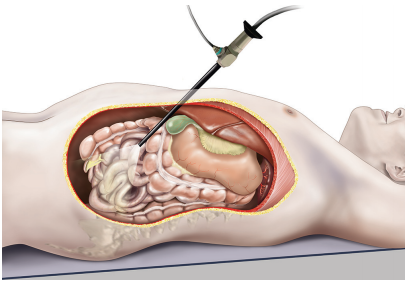What is a diagnostic laparoscopy?
A diagnostic laparoscopy is an operation using keyhole surgery to look at your abdominal and pelvic organs. For some people minor treatments can be performed at the same time. A diagnostic laparoscopy is good for finding out the cause of abdominal and pelvic pain.
What are the benefits of surgery?
A diagnostic laparoscopy may allow your doctor to find out the cause of your symptoms.
Are there any alternatives to surgery?
It may be appropriate to try to find the cause of your symptoms using a blood test, x-rays and scans.
What does the operation involve?
The operation is usually performed under a general anaesthetic. The operation usually takes about 20 minutes. Your surgeon will make one or two small cuts on your abdomen. They will insert surgical instruments along with a telescope so they can see inside your abdomen and perform any minor procedures (see figure 1).
What complications can happen?
1. General complications
- Pain
- Feeling or being sick
- Bleeding
- Infection of the surgical site (wound)
- Unsightly scarring
- Blood clots
2. Specific complications
- Damage to internal structures
- Developing a hernia
- Surgical emphysema
- Failure to find out what the problem is
- Failed procedure
- Infection of the pelvic organs or bladder
How soon will I recover?
You should be able to go home the same day or the day after. The healthcare team will tell you what was found during the laparoscopy and discuss with you any treatment or follow-up you need. Rest for one to two days and take painkillers if you need them. Regular exercise should help you to return to normal activities as soon as possible. Before you start exercising, ask the healthcare team or your GP for advice.
Summary
A diagnostic laparoscopy helps to find out the cause of certain abdominal and pelvic problems. For some people minor treatments can be performed at the same time.
Acknowledgements
Author: Prof Simon Parsons DM FRCS (Gen. Surg.) Illustrations: Medical Illustration Copyright © Medical-Artist.com
This document is intended for information purposes only and should not replace advice that your relevant health professional would give you.
